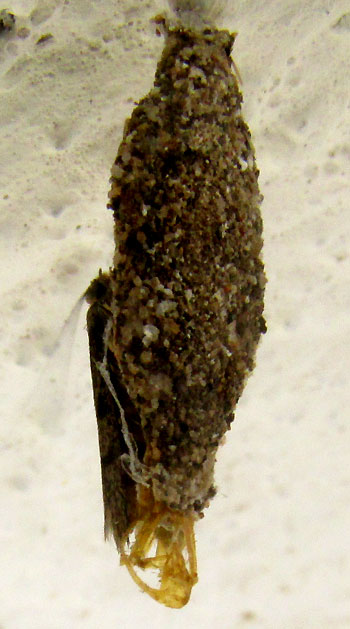Excerpts from Jim Conrad's
Naturalist Newsletter
entry dated March 23, 2023, issued from near Tequisquiapan, elevation about 1,900m (6200 ft), Querétaro state, MÉXICO
CASE-BEARING CLOTHES MOTH

On the ceiling of a basement painted with white limewash -- limewash being lime (calcium oxide, or CaO) mixed with water -- about twenty cocoons like the one at the right, around 13 or 14mm long (½ inch), had been hanging on the ceiling and walls for months. Finally, from one cocoon, the tiny, slender moth seen on the bottom, left of the cocoon emerged and kept still for hours. At least when I approached close enough to photograph, it would nervously wave its antennae, blurring them in our slow-shutter pictures.
Because such cocoons sometimes are found in homes, I suspected that these were clothes moths. The most commonly noticed clothes moth species worldwide is the Common Clothes Moth, Tineola bisselliella. However, when I enlarged my pictures on the computer screen, the ceiling-hanging moth didn't look like that species. Another nearby moth soon had just emerged from its cocoon stuck on a wall and, below, its picture better shows details unlike those of the Common Clothes Moth:

In contrast to other clothes moth species, our ceiling moth was exceptionally dark, and the wings at the rear end bore longer hairlike appendages, presenting a bushier effect. Our ceiling moth lacks bushy hairs at the back of the small head. Also, in the above photo, three dark spots on the wings are just barely visible on the similarly dark, speckled background. Comparing our pictures with those on the Internet, our individuals matched those of the Case-bearing Clothes Moth, TINEA PELLIONELLA.
The "clothes moth" part of the name genus comes about because the genus Tinea and all its 223 GBIF-database currently recognized species are members of the Clothes Moths Family, the Tineidae. The name Tinea for which the family is named in Latin simply means "moth" or "bookworm." Our little moth deserves such a general name because Tinea pellionella was first scientifically named by Linnaeus himself, back in 1758, when many different kinds of moths were lumped in just a few taxonomic categories.
The "case-bearing" part of the name describes this species' protective silk case in which the caterpillar-type larvae live. They carry it around as they feed, pupate in it, and the mature moth finally exits through the cocoon's free end. The cases are described as consisting of silk, pieces of food, and tiny poops, so the grainy items covering the cases in our pictures must be largely dried-up moth poop.
Tinea pellionella originated in the Old World, but now has spread across the globe, wherever textiles are in use. Before humans began wearing clothes, and even still, members of the family fed on feathers, fur, dead animals and wool.